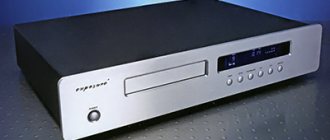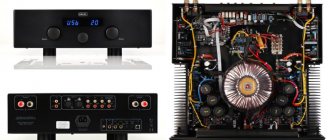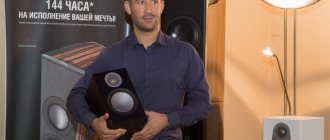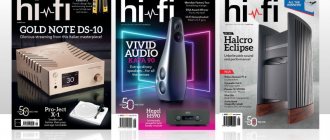CD player Luxman D-08, review. Magazine "WHAT HI-FI?"
The sound is amazingly lively, coherent, devoid of the slightest hint of “digital”. The dynamic range is enormous, the attack and decay of notes are impeccable, and at the very end we note the clarity of the rhythmic pattern at a barely audible volume.
Save and read later -
| A miracle of design thought | Branded developments, the best components and Japanese quality |
| Tempting? | One of the best players we have tested; combines fidelity with natural sound |
Last year (October 2011), in the same magazine section dedicated to the most outstanding components, the Luxman D-06 SACD player was presented, standing one step below the flagship model that we are introduced to today. He made a great impression and left the most pleasant memories of hours of listening. The Luxman D-08 is very similar, only larger, heavier and $7,000 more expensive.
It uses all the company's technological achievements. These include a new LxDTM transport of our own design and a proprietary ODNF feedback circuit in the analog stage, implemented on discrete elements - it has been created and improved over the past years for the flagships of the Luxman line of amplifiers. The player's DAC unit contains the latest Texas Instruments chips - PCM1792A, providing (in theory) a dynamic range of 132 dB. You can also connect third-party digital signal sources to it via SPDIF connections.
The body of the device, replete with buttons, is solid, but quite simple. A characteristic detail of the exterior is the flap that closes the disc tray after it is pulled in.
With the ever-shrinking market for CD recordings, CD player manufacturers routinely cite hundreds of millions of previously released CDs stored in personal music libraries. Japanese marketers also have in mind SACDs, which, with adequate playback, still provide better sound quality. And the Luxman D-08 provides a choice of how to perform digital-to-analog conversion for their playback: the DSD stream can be immediately sent to the appropriate DAC, or the DSD can be converted into PCM format and its processing entrusted to the PCM1792A. This option is also available from the remote control.
Everyone knows that the most difficult music to reproduce well is classical music. But even among the compositions of this genre there are those that only the most high-quality systems can handle - of course, with good recordings. Let’s start the story about the talents of Luxman D-08 with the fact that we listened to “The Rite of Spring”
I. Stravinsky (CD
Stravinsky The Rite of Spring. Oslo Philharmonic Orchestra, Mariss Jansons
). The player allowed us to capture the complex rhythm and harmony in that incredible pile of sounds that in other cases seems like a sheer cacophony. This is only possible with impeccable accuracy and detail in every sense - tonal, timbral, spatial. The sound is amazingly lively, coherent, devoid of the slightest hint of “digital”. The dynamic range is enormous, the attack and decay of notes are impeccable, and at the very end we note the clarity of the rhythmic pattern at a barely audible volume.
On SACD recordings, for example Tchaikovsky: Symphony No.6. Wiener Philharmoniker, Valery Gergiev
, we compare two methods of digital-to-analog playback of this format. Both provide spacious, large-scale, emotional sound; it is assertive, but smooth and musical; We note the speed and thoroughness of the dynamics. With RSM transformation it is more decisive and energetic; in the DSD case, the scene is deeper, the nuances are subtler.
For all its meticulousness, the D-08 is very loyal to lower-quality recordings: from CD Requiem. Mozart Wiener Philharmonieker. Herbert von Karajan
it brings out the good stuff and hides the shortcomings, delivering a listening experience that's driven by the artist's craftsmanship. It works just as thoroughly with digital streams from other sources, including HD formats.
The same can be said about less difficult genres; The only question that arises is whether it is worth spending so much on something that will sound good and with more affordable components. But if you have no problems with funds, and your love for music and demands for its performance are great, then you simply need to take a closer look at the Luxman D-08. This is one of the best players we have encountered.
In detail.
Transport mechanism LxDTM
| To maximize the protection of the laser head of the CD transport from vibrations and increase the accuracy of reading data from the disk, this unit is placed in a metal box with 9 mm stiffening ribs. The die-cast aluminum disc tray features an automatically closing flap to keep the reader dust-free and immobile. |
| BEHIND | Exceptionally accurate and detailed, as well as lively and rich sound; DAC function for third party sources. |
| AGAINST | Nothing. |
| VERDICT | One of the best SACD players on an absolute quality scale that we have encountered. |
IN THE LANGUAGE OF NUMBERS
- Media
CD, 2-channel SACD - Line outputs
Balanced XLR, unbalanced RCA - Digital outputs
Coaxial, optical - Digital inputs
Coaxial, 2 optical - Dimensions (H x W x D)
15 x 44 x 41 cm - Weight
22.5 kg
Prepared based on materials from the magazine “WHAT HI-FI?”, September 2012
www.whathifi.ru This review was read 5,531 times
PRICE PER SET! ONLY INCLUDED WITH LUXMAN C-7f.
LUXMAN M-7f
390,000 Yen in October 2000.
The LUXMAN M-7 series of amplifiers was so successful that without significant changes it lasted on the assembly line for more than 5 years and like a locomotive pulled the legendary manufacturer into the new millennium. But we must remember that the financial crisis of the mid and late nineties buried a huge number of very respected and richer manufacturers than LUXMAN.
And the secret of the success of the 7th series was absolutely predictable. All circuitry has been developed and polished for decades. Everything is also controlled by OOS (the absence of which some craftsmen boast). But LUXMAN engineers have learned to manage this negative connection, and not just manage, but manage for their own benefit. For this purpose, the latest “OOS Distortion Control” scheme was used; the ODNF scheme analyzed and corrected the relationship between the musical signal and distortion in real time. To achieve this goal, an ultra-wideband circuit has been developed with ultra-high-speed output voltage slew and low distortion, which does not require correction for circuit amplification in terms of music signal and phase correction. In addition, by using a super low-frequency DC servo amplifier, it was possible to eliminate the timbre coloration of low frequencies that inevitably appears during OOS.
To operate without distortion at high power, an ultra-efficient high-power 530VA toroidal transformer was used, paired with electrolytic capacitors of huge 2x22000 uF capacitance with instant response. These measures eliminated electrical starvation even at maximum signal levels.
The specially designed FRB chassis absorbs all vibrations with ease and provides a strong base for mounting all amplifier units. Each unit, in turn, is located in a separate box and is completely isolated from harmful electromagnetic interference.
Accordingly, exclusively audiophile element base was used. According to the rules adopted by LUXMAN since ancient times, all elements underwent preliminary testing. The ground bus and connecting conductors were made of highly purified copper, and all contacts were gold-plated.
The huge dial indicators, hidden behind a 10 mm acrylic panel, look irresistible.
The amplifier has huge output terminals that can “tightly” secure a conductor of any “reasonable” cross-section. With an eye toward professional equipment, the LUXMAN M-7f is equipped with coaxial and balanced inputs, with the ability to adjust input levels for each channel.
In sound, this is the purest LUXMAN, with all the epithets of the highest dignity inherent in this brand. Without a doubt, in conjunction with the LUXMAN C-7f, it will become the center of attraction of your entire system and will perform musical works of any genre and complexity in the most worthy manner.
| Form | Stereo power amplifier | |
| Power | Per channel: In mono mode: | 300W+300W(4Ω) 200W+200W(8Ω) 600W(8Ω) |
Luxman lovers table
I came across this idea on one of the forums.
Luxman, great post! The L series has served me for 20 years! There were different models, but the L 190, although the youngest in the line, I like more than the others, more soulful or something.
Who listened to this 190? There are 10-12 thousand on Avito. They also write about him.
■ The 70-80s of the last century can be called the “golden age” of the Japanese company Luxman. Their Hi-Fi components have earned fans the reputation of sophisticated musical performers Courtesy of Kings AMPLIFIER LUXMAN L-190 YEAR OF PRODUCTION 1984 MANUFACTURING COUNTRY JAPAN PRICE AT THE TIME OF RELEASE $400
The Luxman amplifier that came to us is the youngest model in the legendary line of amplifiers that used Duo-Beta Circuit technology; it was the last one issued before the company's shares were bought by Alpine Group (see sidebar). According to the Luxman , this model is “designed for those who want to discover the world of quality hi-fi equipment at a minimal price.” Well, the competition in the budget amplifier market today is quite serious - it will be interesting to see what this rarity is capable of in comparison with new devices. It should be immediately noted that the terminals for connecting speakers on the Luxman L-190 cannot be called convenient: it is suggested to insert a thin wire into the holes for the cable and tighten it with plastic screws. Otherwise, there are no problems with controlling the amplifier, and the lack of a remote control for products in this price category is not surprising in our time. Quite quickly after switching on, the main feature of this Luxman was revealed: polite, but too (even exaggerated) soft sound. You have to select the appropriate player: if with the restrained budget models of Rotel and Cambridge Audio the amplifier sounds accurate and comfortable, then when paired with the Luxman D-102 player it gives excessive elegance even to Diana Krall’s voice. The specific coloring introduced by L-190 can be enhanced by an incorrectly selected interconnect cable. However, in any combination, all compositions were played in great detail - for example, on the album of the Ulytau group one could easily determine the moment the bow touched the violin strings, and the performance of the Schubert sonata by Norwegian pianist Leiv Ove Andsnes demonstrated the excellent microdynamics of the device. Of course, the older models of the Luxman (the famous L-510, L-530 and L-550) sound as “sugary” as the younger ones, and surprise the listener with the sophistication of their approach to complex musical material. However, they also have genre preferences - classics, as well as vocal and acoustic jazz, suit this family much better than hard rock. Founded in 1925, Luxman began as an importer of fine art and picture frames from Europe. This is certainly reflected in the company's approach to audio products: each device, according to the Luxman philosophy, is a complete work. Sometimes the desire to improve serial models played a cruel joke on the company’s engineers: for example, the idea of making the windings of output transformers manually in the late 50s led to serious financial losses - despite the fact that audiophiles recognized the unconditional advantages of Luxman of those years. The first integrated amplifier with a power of 10 W per channel, which combined miniature triodes and the aforementioned 0Y type transformer, came out in the mid-60s - this model, the SQ-38, was produced for several decades. Another well-known example of Luxman's was the improved STAR Circuit power supply, which provided independent power to each of the amplifier circuits, which significantly reduced noise levels. In 1985, Luxman became part of the Alpine Group holding company, and in the late 90s the right to use its name was acquired by Korean manufacturers. A couple of years ago, the production of high-quality equipment under the Luxman was resumed, and products of this brand can again be found on the shelves of Russian audio showrooms.








